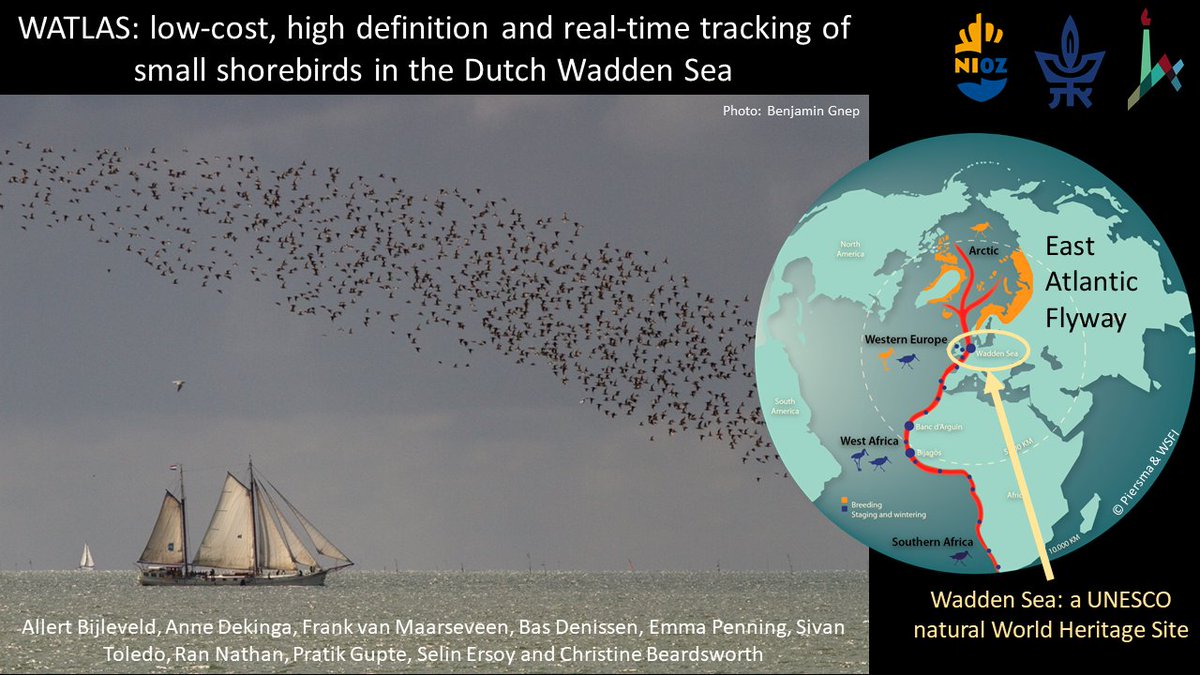1 #ISTC20 #Sesh9
Millions of shorebirds fly to the Wadden Sea yearly for its resource-rich mudflats. But its heavily populated coast, fishing, and mineral reserves make it vulnerable to habitat destruction. To understand effects on habitat use, it is important to track birds
Millions of shorebirds fly to the Wadden Sea yearly for its resource-rich mudflats. But its heavily populated coast, fishing, and mineral reserves make it vulnerable to habitat destruction. To understand effects on habitat use, it is important to track birds
2 #ISTC20 #Sesh9
We have set up #WATLAS to track 100s of shorebirds simultaneously. Tags cost 40€ and depending on battery size, weigh as little as 1g. Using an array of 26 receivers, positions are calculated from differences in tag-signal arrival times http://ieeexplore.ieee.org/document/7515410">https://ieeexplore.ieee.org/document/...
We have set up #WATLAS to track 100s of shorebirds simultaneously. Tags cost 40€ and depending on battery size, weigh as little as 1g. Using an array of 26 receivers, positions are calculated from differences in tag-signal arrival times http://ieeexplore.ieee.org/document/7515410">https://ieeexplore.ieee.org/document/...
3 #ISTC20 #Sesh9
In 2019 we tracked 255 red knots at 1/6Hz. In combination with habitat monitoring, we ask where birds go, what they eat, and who they are with #collectiveBehaviour. We also assay #animalpersonality explaining variation in #movementecology http://royalsocietypublishing.org/doi/10.1098/rspb.2013.3135">https://royalsocietypublishing.org/doi/10.10...
In 2019 we tracked 255 red knots at 1/6Hz. In combination with habitat monitoring, we ask where birds go, what they eat, and who they are with #collectiveBehaviour. We also assay #animalpersonality explaining variation in #movementecology http://royalsocietypublishing.org/doi/10.1098/rspb.2013.3135">https://royalsocietypublishing.org/doi/10.10...
4 #ISTC20 #Sesh9
Monitoring this many individuals for months provides insights into long-term #movementecology strategies. Do they consistently use the same sites? What characterizes these sites? Is it the abundance and quality of prey? (Spot the site faithful knots #challenge)
Monitoring this many individuals for months provides insights into long-term #movementecology strategies. Do they consistently use the same sites? What characterizes these sites? Is it the abundance and quality of prey? (Spot the site faithful knots #challenge)
5 #ISTC20 #Sesh9
By mapping prey abundances with #SIBES http://www.nioz.nl/en/about/cos/coastal-dynamics/sampling-the-intertidal-macrofauna-with-SIBES%C2%A0,">https://www.nioz.nl/en/about/... we find that food is key to understanding spatial distributions. But availability is highly dynamic in this ecosystem so long-term monitoring is important! http://www.royalsocietypublishing.org/doi/full/10.1098/rspb.2015.1557">https://www.royalsocietypublishing.org/doi/full/...
By mapping prey abundances with #SIBES http://www.nioz.nl/en/about/cos/coastal-dynamics/sampling-the-intertidal-macrofauna-with-SIBES%C2%A0,">https://www.nioz.nl/en/about/... we find that food is key to understanding spatial distributions. But availability is highly dynamic in this ecosystem so long-term monitoring is important! http://www.royalsocietypublishing.org/doi/full/10.1098/rspb.2015.1557">https://www.royalsocietypublishing.org/doi/full/...
6 #ISTC20 #Sesh9
#WATLAS in combination with #SIBES, gives important information on shorebirds, which we can offer to #waddenzee managers and policy makers.
Curious? Follow the birds live on http://www.nioz.nl/watlas ,">https://www.nioz.nl/watlas&qu... and read the team’s fieldwork blog on https://www.nioz.nl/en/blog/watlas-x-niozatsea">https://www.nioz.nl/en/blog/w...
#WATLAS in combination with #SIBES, gives important information on shorebirds, which we can offer to #waddenzee managers and policy makers.
Curious? Follow the birds live on http://www.nioz.nl/watlas ,">https://www.nioz.nl/watlas&qu... and read the team’s fieldwork blog on https://www.nioz.nl/en/blog/watlas-x-niozatsea">https://www.nioz.nl/en/blog/w...

 Read on Twitter
Read on Twitter





